Ash (Fraxinus) is a genus of flowering plants in the olive and lilac family, Oleaceae. It contains 45–65 species of usually medium to large trees, mostly deciduous though a few subtropical species are evergreen. European ash (F. excelsior) is our tallest native deciduous tree in the UK when fully mature. Ash trees grow up to 40m tall and can live up to 400 years, but coppiced trees can live even longer.
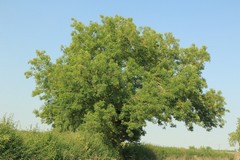
Ash tree in late Summer
The name Ash originates from the old English 'aesc' meaning 'spear'.
Rowans or mountain ashes have leaves and buds superficially similar to those of true ashes but belong to the unrelated genus Sorbus in the rose family.
Ash is found across Europe, from the Arctic Circle to Turkey. With around 80 million specimens, the ash is the third most populous tree in Britain after the oak and the birch.
Leaves are compound pinnate, typically comprising 3-6 opposite pairs of light green, oval leaflets with long tips, up to 40cm long. There is an additional singular 'terminal' leaflet at the end. There are no stalks to the side leaflets. They are pointed and toothed, with hairs on the lower surface. Leaves can turn in the direction of sunlight, and sometimes the crown of the tree may lean towards the sun. The leaves appear relatively late in Spring, and are amongst the first to be shed in Autumn, whilst still green.
Ash thrives best in fertile, deep and well drained soil in cool atmospheres and also in limestone areas. It often dominates British woodland.
Ash trees make the perfect habitat for a number of different species of wildlife. The airy canopy and early leaf fall allow sunlight to reach the woodland floor, providing optimum conditions for wildflowers such as dog violet, wild garlic and dogs mercury, and consequently insects including various species of butterfly.
The dappled shade beneath its leaves is ideal for many of the lichens that grow on tree bark and wood. Like elm, the bark of ash has a relatively high pH, which is a requirement for many lichens. Several species that were severely affected by loss of habitat following Dutch Elm Disease now live on ash.
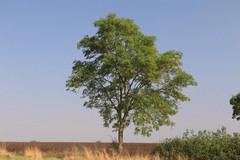
The dappled shade beneath the tree is ideal
for ground cover plants and also it used to be
common for hazel to grow beneath the ash
Ash is dioecious, meaning that male and female flowers typically grow on different trees. Both male and female flowers are purple and appear before the leaves in spring, growing in spiked clusters at the tips of twigs.
However, some trees are wholly female and others are mainly male with some female branches.
With age ash may change its sexual function from predominantly male and hermaphrodite towards femaleness. Sometimes male and female flowers appear on the same tree.
Female flowers are pollinated by wind, and they develop into winged fruits, or keys, in autumn. They are dispersed by birds and mammals after falling from the tree. The seeds, also commonly called helicopters, are a type of fruit known as a samara. A samara is a winged achene, a type of fruit in which a flattened wing of fibrous, papery tissue develops from the ovary wall. A samara is a simple dry fruit and indehiscent (not opening along a seam). The shape of a samara enables the wind to carry the seed farther away than regular seeds from the parent tree.
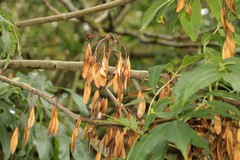
Seeds (helicopters) ready to fall in late
September
Bullfinches eat the winged seeds and woodpeckers, owls, redstarts and nuthatches use the holes left by fallen branches for nesting. Because trees are so long lived, they support deadwood specialists such as the lesser stag beetle.
It is one of the toughest hardwoods and absorbs shocks without splintering. It is used for making tools and sport handles, including hammers, axes, spades, hockey sticks, oars and bows. It is also used for furniture. Ash coppices well, which traditionally provided firewood and charcoal.
The ash tree was thought to have medicinal and mystical properties and the wood was burned to ward off evil spirits. The Norse tree of life, Yggdrassil, whose crown was in heaven and roots in hell was a giant ash. Norse mythology also records that the first man was made from an ash. Even today it is sometimes known as the 'Venus of the woods'. In Britain we regarded ash as a healing tree.
Elsewhere in Europe, snakes were said to be repelled by ash leaves or a circle drawn by an ash branch. Irish folklore claims that shadows from an ash tree would damage crops.
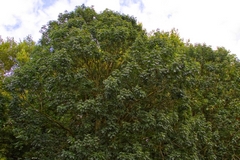
Around one third of British woodland trees
are ash
In Cheshire, it was said that ash could be used to cure warts and rickets. In Sussex, the ash tree and the elm tree were known as "widowmakers" because large boughs would often drop without warning.
In ancient times, it was believed to possess spiritual powers, with druids’ wands and witches’ broomsticks invariably made from ash.
The outlook for the ash is looking bleak. The trees are suffering a twin-pronged attack: from ash dieback, a fungal disease also known as Chalara, and from the invasive emerald ash borer beetle. The beetle has yet to reach the UK, but is moving westwards across Europe. Chalara arrived in 2012.
Ash dieback, is caused by the Hymenoscyphus fraxineus fungus (previously Chalara fraxinea) and has a very high mortality rate. In 2016, the ash tree was reported as being in danger of extinction in Europe.
The disappearance of ash trees would not just affect our woodlands, but also the 1,000-plus species that depend on it, including more than 200 different invertebrates.
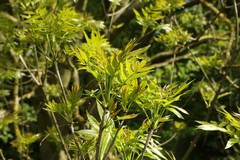
New ash leaves in May
Some trees seem able to recover from die back, while others don’t catch it at all. Exactly why is unclear, but the long-term hope is that a resistant strain of ash can be developed. However this is no quick solution. In the near future Britain stands to loose millions of Ash trees, as has happened throughout Europe.